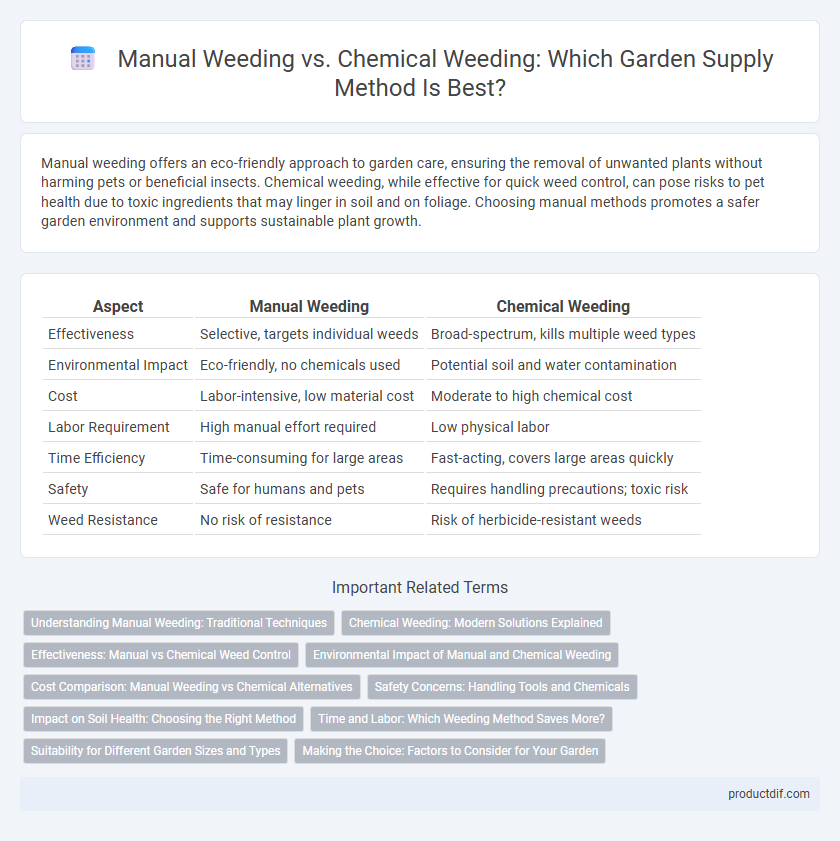Manual weeding offers an eco-friendly approach to garden care, ensuring the removal of unwanted plants without harming pets or beneficial insects. Chemical weeding, while effective for quick weed control, can pose risks to pet health due to toxic ingredients that may linger in soil and on foliage. Choosing manual methods promotes a safer garden environment and supports sustainable plant growth.
Table of Comparison
| Aspect | Manual Weeding | Chemical Weeding |
|---|---|---|
| Effectiveness | Selective, targets individual weeds | Broad-spectrum, kills multiple weed types |
| Environmental Impact | Eco-friendly, no chemicals used | Potential soil and water contamination |
| Cost | Labor-intensive, low material cost | Moderate to high chemical cost |
| Labor Requirement | High manual effort required | Low physical labor |
| Time Efficiency | Time-consuming for large areas | Fast-acting, covers large areas quickly |
| Safety | Safe for humans and pets | Requires handling precautions; toxic risk |
| Weed Resistance | No risk of resistance | Risk of herbicide-resistant weeds |
Understanding Manual Weeding: Traditional Techniques
Manual weeding involves physically removing weeds by hand or using simple tools like hoes and hand trowels, preserving soil health and preventing chemical runoff. Traditional techniques include pulling weeds at their base to prevent regrowth and using shallow cultivation to disrupt weed roots without disturbing the main crop. This method is labor-intensive but promotes organic gardening practices and maintains biodiversity in the garden ecosystem.
Chemical Weeding: Modern Solutions Explained
Chemical weeding offers a fast and efficient approach for controlling invasive weeds by using herbicides formulated for specific plant species, ensuring targeted action without harming desired crops. Modern solutions incorporate selective herbicides and environmentally safer formulations that minimize soil contamination and reduce the risk of chemical resistance. Advances in precision application technology further enhance the effectiveness and sustainability of chemical weeding in garden supply management.
Effectiveness: Manual vs Chemical Weed Control
Manual weeding offers precise control by physically removing weeds, preventing herbicide resistance and minimizing environmental impact, yet it requires significant labor and time investment. Chemical weeding provides rapid and broad-spectrum weed suppression, effectively reducing large infestations with minimal physical effort but may lead to soil contamination and potential harm to beneficial plants. Choosing between manual and chemical weed control depends on garden size, weed species, environmental concerns, and long-term sustainability goals.
Environmental Impact of Manual and Chemical Weeding
Manual weeding significantly reduces environmental harm by avoiding chemical runoff and preserving soil biodiversity, promoting healthier ecosystems. Chemical weeding introduces herbicides that can contaminate soil and water sources, posing risks to non-target plants, animals, and beneficial microorganisms. Sustainable garden management favors manual weeding methods to maintain ecological balance and prevent long-term environmental degradation.
Cost Comparison: Manual Weeding vs Chemical Alternatives
Manual weeding requires minimal upfront investment, typically involving basic tools like hoes or hand weeders, making it cost-effective for small gardens but labor-intensive and time-consuming. Chemical weeding entails the purchase of herbicides, which can be more expensive initially, but offers faster and widespread weed control, potentially reducing labor costs in large-scale garden maintenance. Long-term expenses may vary based on weed resistance development, environmental impact mitigation, and the frequency of applications needed to maintain weed-free soil.
Safety Concerns: Handling Tools and Chemicals
Manual weeding involves direct contact with sharp tools, requiring proper handling and protective gloves to prevent cuts and skin irritation. Chemical weeding uses herbicides that can pose risks such as respiratory issues and skin burns if inhaled or improperly applied, necessitating the use of masks, gloves, and eye protection. Ensuring safe practices in both methods minimizes health hazards and environmental contamination in garden maintenance.
Impact on Soil Health: Choosing the Right Method
Manual weeding preserves soil health by minimizing chemical residues and maintaining beneficial microorganisms, promoting a balanced ecosystem. Chemical weeding, while efficient, can disrupt soil microbial activity and reduce soil fertility over time due to toxic chemical buildup. Gardeners should assess soil conditions and long-term sustainability when selecting between manual and chemical weeding methods to ensure optimal soil vitality.
Time and Labor: Which Weeding Method Saves More?
Manual weeding demands significant time and physical labor, often requiring frequent attention to prevent weed overgrowth, making it labor-intensive for large gardens. Chemical weeding drastically reduces time spent by targeting weeds quickly and efficiently, allowing gardeners to focus on other tasks. However, the choice between manual and chemical weeding depends on garden size, plant sensitivity, and gardener's preference for labor investment versus speed.
Suitability for Different Garden Sizes and Types
Manual weeding suits small to medium-sized gardens and organic setups where precise root removal is essential without harming nearby plants or soil health. Chemical weeding is more effective for large-scale gardens, farms, or areas with persistent, widespread weed problems, offering rapid control but requiring careful selection to avoid plant damage. Gardeners should consider garden size, plant diversity, and environmental impact when choosing between manual and chemical weed control methods.
Making the Choice: Factors to Consider for Your Garden
Manual weeding provides precise removal of unwanted plants, promoting soil health and avoiding chemical residues, ideal for small or organic gardens. Chemical weeding offers faster control of extensive weed infestations but requires careful selection of herbicides to prevent damage to desired plants and minimize environmental impact. Consider factors such as garden size, plant types, weed severity, and your commitment to sustainable practices when choosing between manual and chemical weed control methods.
Manual Weeding vs Chemical Weeding Infographic

 productdif.com
productdif.com